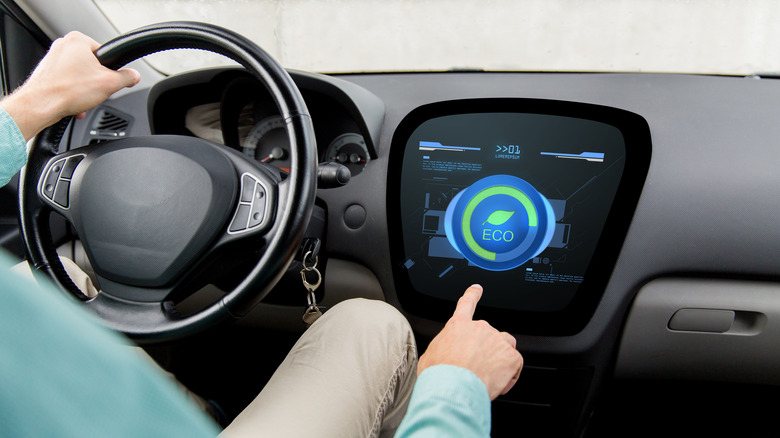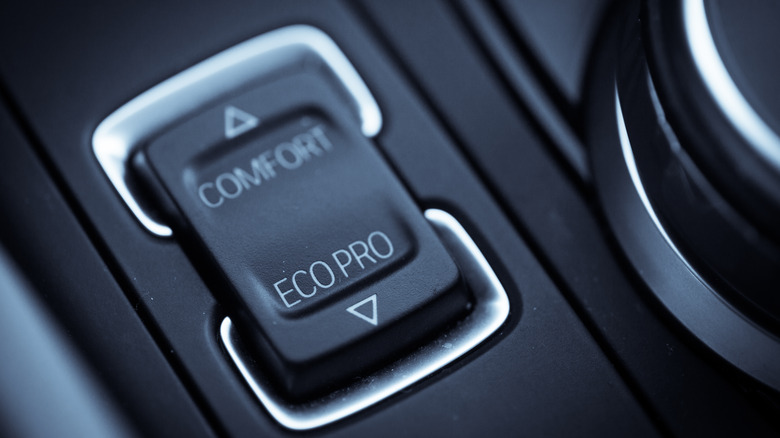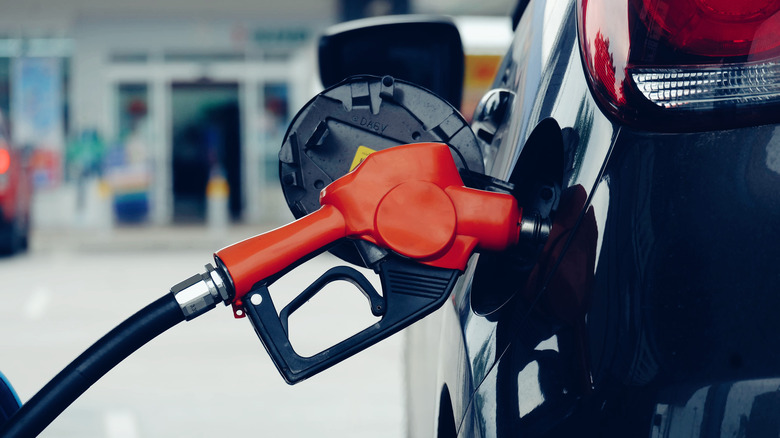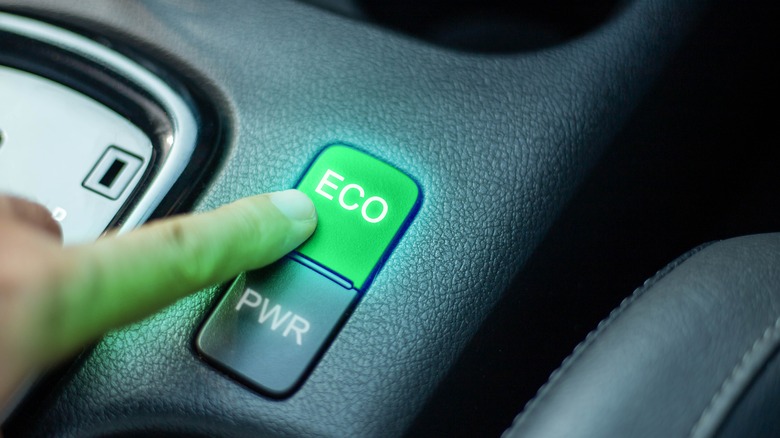Here's What The Eco Mode In Your Car Actually Does
Modern cars have so many buttons you might feel like you need to be an automotive expert to keep up with them. The names on these buttons can give you an idea of what they do; for example, looking at your car's sports mode button, you might conclude activating it would give your car a sportier feel, and you'd be right. In contrast, eco mode isn't quite as easy to decipher at first glance. You may wonder if eco is short for economical or ecological. If you said economical, you'd be correct again. Even with that information, it's unclear what it does, so nobody would blame you for ignoring the eco button in favor of driving in standard mode. And in reality, in many cars there aren't substantial differences between the two modes.
Switching on your car's eco mode should make it more fuel-efficient, cutting back on how hard the engine works and slowing down acceleration. If you tend to have a lead foot when driving, eco mode can help slow you down because it reduces the throttle response and limits how fast the engine can rev. Theoretically, this should lead to your vehicle using less gas and decreasing its carbon footprint. You probably won't want to use eco mode if you are trying to get somewhere fast, but if you have time on your hands and are out for a leisurely drive, that could be the perfect time to give it a try.
What is eco mode?
With the price of gas, most drivers are looking for ways to save money at the pump. There are a few ways to go about doing this. You could buy one of the most fuel-efficient cars of 2024 or download an app to help you save on gas. Another option is to engage your vehicle's eco mode to use less gas and reduce emissions. Car manufacturers designed eco mode to improve a vehicle's fuel economy. It does this by changing how your car operates in a few important ways: It makes the throttle less reactive, so the car won't accelerate as quickly, even when you press the gas pedal to the floor; it makes adjustments to your vehicle's transmission so that it shifts at lower RPMs, so you may notice that your car shifts into higher gears sooner than in standard mode; and in some vehicles, eco mode might reduce the capacity of or turn off energy-consuming features like air conditioning, heated seats, and steering.
Eco mode is available in a range of cars, including hybrids and electric vehicles (EVs), traditional internal combustion engine vehicles, and luxury and performance vehicles. In hybrids and EVs, eco mode maximizes battery usage and overall efficiency. In modern gas and diesel cars, eco mode helps drivers save fuel and reduce emissions. High-performance brands like Mercedes-Benz and BMW also have an eco mode, allowing drivers to balance power with efficiency.
What are the benefits of using eco mode?
All things being equal, the adjustments eco mode makes to your car's engine and transmission should optimize fuel consumption, saving you money on gas and cutting down on emissions. According to a study conducted by Toyota, using eco mode in a Toyota or Lexus leads to significant reductions in fuel consumption and CO2 emissions, saving thousands of gallons of gasoline, translating into a fuel cost savings of $18,304 compared to the national average. Toyota's data scientists also found that eco mode could decrease tailpipe emissions by up to 26%.
While these numbers look great on paper, there is still a lot of debate about whether eco mode results in any significant improvements in fuel economy. For example, Consumer Reports tested various vehicles in eco mode as part of its fuel economy tests and didn't find any substantial benefits for city or highway driving. However, they did note that one benefit of eco mode is teaching people how to drive more smoothly, which can improve fuel economy.
Similarly, there is conflicting information on whether eco mode increases or decreases car wear and tear. When used correctly, eco mode shouldn't hurt your car's engine and might extend its lifespan. However, with low-volume engines, you should be careful because less oil circulates when the engine runs at a lower speed, making it less effective at lubricating and cooling the engine components. Furthermore, eco mode causes the gears to constantly shift between high and low, which can have a negative impact on cars with an automatic transmission.
When to use eco mode?
If you've decided to try out your car's eco mode, you might be wondering when you should use it. Given that your vehicle will operate with reduced power in eco mode, it works best when you won't need to accelerate rapidly, such as in congested suburban streets or slow-moving traffic. Eco mode excels in city driving, where stop-and-go traffic is common. Since eco mode reduces the throttle response and shifts gears at lower RPMs, it can help you save fuel in urban areas where the transmission often has to work nonstop.
You may also want to consider using eco mode when going on a long trip where you'll be driving at moderate speeds (between 30 and 60 mph), such as highway driving with cruise control. In these situations, eco mode can improve fuel efficiency by keeping the engine running at lower RPMs, which conserves fuel over long distances.
There are also times when you'll want to avoid putting your car in eco mode because it may do more harm than good. Eco mode isn't the best choice for high-speed highway driving, where you might need to accelerate quickly to overtake a car or merge with traffic. The reduced power output can hurt your vehicle's performance in these situations. You also won't want to use eco mode if you will be towing or going up steep inclines because the reduced torque and power might not provide the necessary performance to handle these conditions safely.



